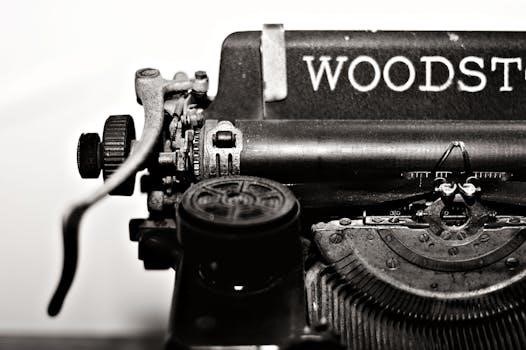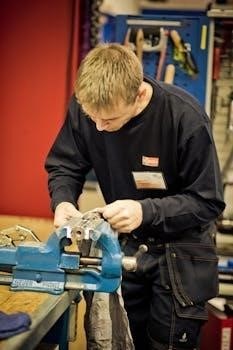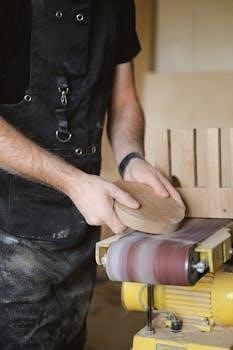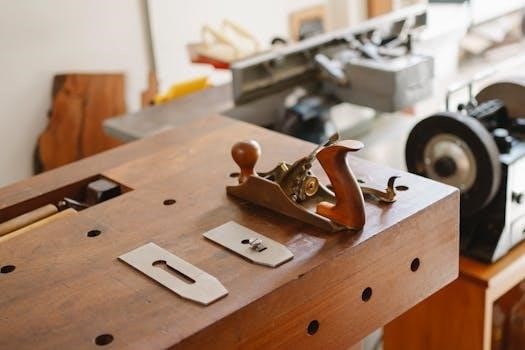Manual moulding machines utilize human force to shape materials. They are versatile for small-scale production and custom designs. These machines offer an affordable entry point for prototyping and specialized molding. They are used across varied applications.
Overview of Manual Moulding Machines
Manual moulding machines are fundamental in the realm of manufacturing‚ offering a hands-on approach to shaping materials. These machines rely on manual power‚ rather than automation‚ making them suitable for small-scale production‚ prototyping‚ and custom designs. Unlike their automated counterparts‚ manual machines are operated by individuals who control each step of the moulding process. Manual machines are often used for optimizing molding parameters offline before large-scale production‚ thus allowing for product development. This allows for flexibility and cost-effectiveness in creating complex parts. They are simpler and more affordable‚ making them accessible to smaller businesses and workshops.

Types of Manual Moulding Machines
Manual moulding machines encompass various designs‚ including ram-jolt squeeze and manual injection machines. Each type serves specific purposes‚ catering to different materials and production needs. These machines offer diverse methods for molding.
Ram-Jolt Squeeze Molding Machines
Ram-jolt squeeze molding machines are a type of manual machine used in foundries. These machines combine jolting and squeezing actions to compact sand molds effectively. The ram-jolt mechanism helps to uniformly distribute sand within the flask‚ while the squeeze action ensures the mold achieves the necessary density and strength for casting. These machines are designed for heavy-duty‚ long-term use and can withstand demanding work environments. They are particularly useful for creating high-quality molds with consistent compaction. Manufacturers like EMI and Osborn offer reliable ram-jolt squeeze molding machines‚ known for their robust construction and dependability in the foundry industry. These machines are essential for producing molds with the required density.
Manual Injection Molding Machines
Manual injection molding machines are designed for small-scale plastic part production. These machines rely on human force to inject molten plastic into a mold cavity. They are ideal for prototyping‚ small production runs‚ and educational purposes. Manual injection machines are often compact and affordable‚ making them accessible for home workshops and small businesses. Unlike their automated counterparts‚ manual machines offer hands-on control over the injection process. They can be operated with precision for producing parts and are often favored by hobbyists. These machines provide a cost-effective solution for creating custom parts; A manual machine can be a useful tool alongside 3D printers.
Other Manual Molding Machine Types
Besides ram-jolt squeeze and manual injection machines‚ several other manual molding types exist. These include machines for sand casting‚ designed for offline cleaning and parameter optimization. These machines are especially useful for developing new products before large-scale production. Some manual machines are used with original molds for product development. They also suit applications requiring specific molding compounds. The manual sand molding equipment is popular among foundries. Manual molding machines are designed for flexibility. These machines play a role in customized mold designs. They provide a way for businesses to optimize processes. These various manual machines cater to niche needs in manufacturing processes.
Components and Operation
Manual molding machines consist of a frame‚ mold clamps‚ and a material injection system. Operation involves manual loading‚ clamping‚ and material injection. Precision is controlled by the operator‚ enabling customized molding.
Key Components of Manual Machines
Manual moulding machines typically include several key components. First‚ the frame provides structural support. Clamps secure the mold halves together. A material injection system‚ often a plunger or lever‚ forces material into the mold. Heating elements‚ like bend heaters‚ maintain material temperature if needed. A rack and pinion system assists in material injection. Energy regulators control the heat. The mold itself‚ designed to create the desired shape‚ is crucial. These components work together to allow for manual‚ hands-on control of the molding process. Manual clamps are common for fastening tools to platens.
Manual Operation Process
The manual operation process begins with securing the mold within the machine. The next step involves loading the molding material into the designated area‚ often a barrel. Then‚ the operator manually applies pressure‚ usually through a lever or plunger‚ to inject the material into the mold cavity. The mold is clamped shut during this process. The material is allowed to cool and solidify inside the mold. Once cooled‚ the mold is opened manually‚ and the finished part is removed. This process relies on the operator’s physical effort and control over the machine’s functions. The process also involves careful setup and adjustments.

Applications and Advantages
Manual molding machines are ideal for prototyping and small-batch production. They allow for customized molds and are cost-effective for niche applications. These machines are also useful in educational settings.
Use Cases for Manual Molding
Manual molding machines find their niche in various applications where precision and small-scale production are key. They are extensively used for creating prototypes‚ allowing designers to test and refine their product designs before committing to large-scale production. Manual machines are also perfect for customized or specialized parts‚ where the demand is not high enough to justify automated systems. In educational settings‚ they offer hands-on experience for students learning about molding processes. Furthermore‚ these machines are beneficial for small businesses and workshops‚ providing an affordable means of production. They are particularly useful for creating unique parts and customized projects‚ which require flexibility and adaptability.
Advantages of Manual Molding
Manual molding machines offer several distinct advantages‚ making them a valuable choice in specific scenarios. Primarily‚ their affordability makes them accessible to small businesses‚ workshops‚ and educational institutions. This lower initial investment enables experimentation and small-batch production without significant capital expenditure. Furthermore‚ manual machines provide enhanced flexibility‚ allowing for easy adjustments and customizations. They are ideal for creating unique parts and prototypes‚ where precision and adaptability are essential. The simplicity of their operation also means less complex maintenance and repair processes. For educational purposes‚ they offer a hands-on learning experience that automated systems can’t match. In short‚ these machines are user-friendly and economical.

Considerations
When using manual moulding machines‚ it’s essential to consider their limitations. Material loading and setup require manual effort‚ and they are less efficient for mass production. Understanding these factors is key for effective operation.
Limitations of Manual Machines
Manual moulding machines‚ while versatile‚ have certain limitations compared to their automated counterparts. Their production capacity is inherently lower‚ making them unsuitable for large-scale manufacturing. The reliance on manual operation introduces variability in the process‚ potentially leading to inconsistencies in the final product. The physical effort required for operation can also limit the duration of use and create fatigue for the operator. Furthermore‚ they often lack the precision and control offered by computer-controlled systems. These machines may struggle with complex designs or materials requiring very specific injection parameters. Manual machines typically have a higher potential for human error‚ impacting the overall quality and efficiency of the molding process. Finally‚ the manual nature of these machines results in higher labor costs per unit produced compared to automated systems.
Material Loading and Setup
The material loading and setup process for manual moulding machines requires careful attention to detail. Typically‚ the process begins with selecting the appropriate raw material‚ such as resin for plastic injection or sand for foundry molding. This material must be prepared according to the manufacturer’s guidelines‚ often involving pre-heating or mixing. The selected mold is then securely installed onto the machine‚ ensuring correct alignment and fastening. Manual clamps are often used to hold the mold in place. The raw material is then loaded into the machine’s hopper or barrel. Temperature controls need to be set manually using regulators for specific materials. The machine is then prepared for operation‚ with checks done for pressure and other variables. This requires a hands-on understanding of the machine and material properties to ensure correct setup.

Manual Machine Manufacturers
Several manufacturers specialize in manual moulding equipment. Key players include EMI and Osborn‚ known for their Ram-Jolt squeeze molding machines. These companies provide reliable solutions for various molding needs;
EMI
EMI is a notable manufacturer of manual moulding machines‚ particularly recognized for their Ram-Jolt squeeze molding technology. Their equipment is engineered for durability‚ ensuring reliable performance in demanding foundry environments. EMI’s machines are designed with heavy-duty construction‚ featuring robust ribbed steel posts and squeeze beams to withstand rigorous use. The swing-head design enhances the efficiency of the molding process‚ allowing for smooth and precise operations. EMI’s product line offers dependable solutions for foundries seeking consistent results in their molding processes. Their machines contribute to the production of high-quality molds‚ essential for various casting applications. They are a long-standing provider for foundries globally.
Osborn
Osborn is another significant manufacturer in the field of manual moulding machines‚ particularly known for their Ram-Jolt series. Their machines‚ like the 200 and 700 series‚ are designed to offer robust performance in foundry settings. These models feature a ram-jolt squeeze mechanism that ensures proper sand compaction for creating high-quality molds. Osborn machines are built to withstand heavy use and provide reliable and consistent results. The company’s focus on durability and precision has made them a trusted choice for foundries seeking efficient manual molding solutions. They provide different model series‚ each designed for specific molding requirements‚ and serve a wide range of casting applications.
